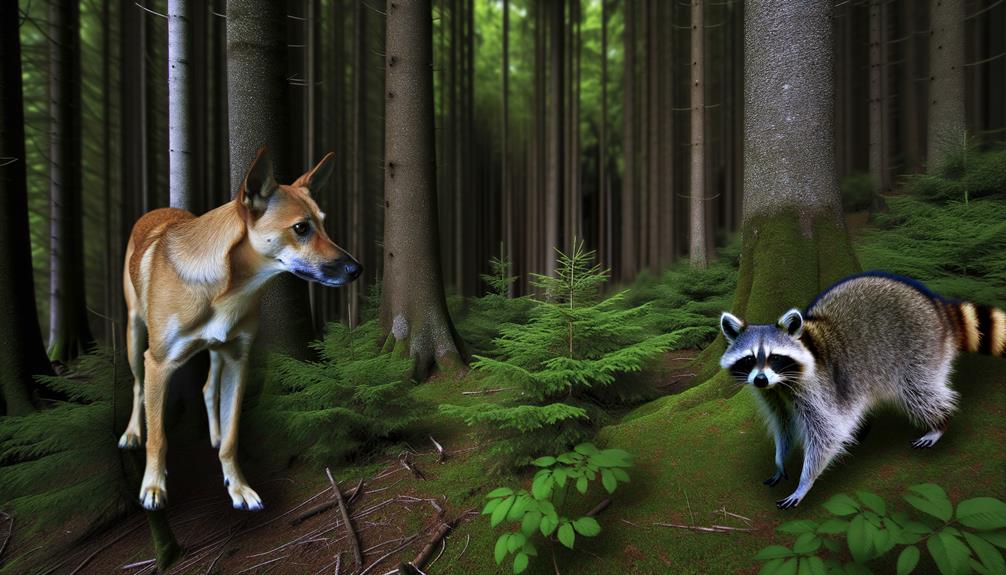How Dogs Get Rabies from Raccoons and Ways to Protect Them
Yes, dogs can get rabies from raccoons. Raccoons are common carriers of the rabies virus and can transmit it through bites or scratches.
This virus affects the central nervous system and can be fatal if left untreated. Vaccinating dogs is critical for prevention.
If a dog encounters a raccoon, immediate veterinary attention and possible post-exposure prophylaxis are essential to avoid transmission. Additionally, understanding raccoon behavior and taking proactive measures can help protect your pet.
By staying informed about this issue, you can effectively mitigate the rabies risk to your dog and household.

Key Takeaways
- Yes, dogs can get rabies from raccoons through bites or scratches.
- Raccoons are common carriers of rabies in North America.
- Vaccination of dogs against rabies is crucial for prevention.
- Immediate action is necessary if a dog encounters a rabid raccoon.
- Quarantine and veterinary consultation are essential after potential exposure.
Rabies and Its Transmission
Rabies is a viral disease that primarily spreads through the saliva of infected animals, typically via bites or scratches. This virus targets the central nervous system, leading to severe neurological symptoms and, if not treated promptly, almost certain death.
The rabies virus can be transmitted to any mammal, including domestic animals like dogs, and humans. Once introduced into a new host, the virus travels through peripheral nerves to the brain, where it multiplies and eventually causes encephalitis.
Early symptoms in animals may include behavioral changes, while advanced stages often present as agitation, excessive salivation, and paralysis.
Given the seriousness of rabies, understanding its transmission is essential for preventing outbreaks and ensuring the safety of both pets and people.
Common Rabies Carriers
Rabies is a viral disease commonly found in various wildlife species, with raccoons, bats, skunks, and foxes being significant carriers. These animals can transmit the virus through bites, scratches, or open wounds, posing a substantial threat to both domestic pets and humans.
Understanding the primary wildlife vectors and their transmission methods is essential for effective prevention and control measures.
Wildlife Rabies Threats
Among the numerous wildlife species known to carry rabies, raccoons are particularly notorious for their role in transmitting the virus to domestic animals such as dogs.
Other notable wildlife rabies carriers include bats, skunks, and foxes. Each of these animals plays a crucial role in the epidemiology of rabies, posing significant threats to both pets and humans.
Understanding these common carriers is essential for effective rabies prevention and control.
Key wildlife rabies carriers include:
- Raccoons: High prevalence in urban and suburban areas.
- Bats: Main source of human rabies cases in the United States.
- Skunks: Notable carriers in certain geographic regions.
- Foxes: Particularly in rural and forested areas.
Awareness and preventive measures can greatly reduce the risk of rabies transmission.
Rabies Transmission Methods
Understanding how rabies is transmitted among common carriers is fundamental to mitigating the risks posed by wildlife, particularly when it comes to protecting domestic animals like dogs. Rabies is primarily spread through the saliva of infected animals, typically via bites or scratches.
Common carriers include raccoons, bats, skunks, and foxes, all of which are prevalent in various regions. These species can harbor the rabies virus asymptomatically, making it challenging to identify potential threats.
When an infected animal bites or scratches, the virus can penetrate the bloodstream of the victim, initiating the infection process. Early detection and prompt vaccination are critical in preventing transmission to domestic pets and ensuring community safety.
Vigilance and proactive measures are key to effective rabies control.
Raccoons and Rabies
Raccoons are among the primary wildlife carriers of rabies in North America, posing a significant threat to both domestic animals and humans. Their prevalence in suburban and urban areas increases the risk of rabies transmission.
Key characteristics of raccoons that contribute to their role in rabies spread include:
- Nocturnal Behavior: Raccoons are active at night, increasing the chances of unnoticed interactions with pets.
- Habitat Adaptability: They thrive in diverse environments, from forests to urban settings.
- Curiosity: Their inquisitive nature often leads them into human-occupied spaces.
- Aggressive Defense: When threatened, raccoons may become aggressive, leading to potential bites or scratches.
Understanding these factors is vital for implementing effective rabies control measures and protecting public health.
Dog-Raccoon Interactions
Dog-raccoon interactions commonly occur in suburban and rural environments where both species are present. These encounters often happen during nighttime or early morning hours when raccoons are most active, posing potential risks such as aggressive confrontations and transmission of diseases like rabies.
Understanding the nature of these interactions is vital for pet owners to implement preventive measures and safeguard the safety of their dogs.
Common Interaction Scenarios
Encounters between dogs and raccoons typically occur in suburban and rural areas, often leading to direct interactions that can pose significant health risks, including the transmission of rabies. These encounters usually happen in the following scenarios:
- Backyard Intrusions: Raccoons often invade yards in search of food, leading to confrontations with resident dogs.
- Trash Bin Raids: Dogs and raccoons may clash over access to garbage, increasing the likelihood of a bite or scratch.
- Outdoor Feeding Stations: Pet food left outdoors can attract raccoons, resulting in close contact with dogs.
- Nature Walks: Dogs off-leash during walks in wooded areas may encounter raccoons, leading to potential skirmishes.
Understanding these scenarios helps in mitigating risks and ensuring pets' safety.
Potential Risks Involved
A significant risk associated with dog-raccoon interactions is the transmission of rabies, a viral disease that can have severe implications for both animal and human health.
Rabies is commonly transmitted through bites or scratches where the virus-laden saliva of an infected raccoon can enter a dog's bloodstream. Infected dogs can then transmit the virus to humans, posing a public health threat.
Additionally, raccoons are known carriers of other zoonotic diseases such as leptospirosis and canine distemper, which can further endanger the health of dogs.
Ensuring that dogs are vaccinated and supervised in areas where raccoons are prevalent can mitigate these risks. Pet owners must remain vigilant and seek immediate veterinary care if exposure is suspected to safeguard both their pets and their families.
Recognizing Rabies Symptoms
Recognizing rabies symptoms in dogs is necessary for early intervention and effective management of the disease. Rabies progresses through distinct stages, each exhibiting specific signs that may indicate infection. Early detection can greatly impact treatment outcomes.
Key symptoms to watch for include:
- Behavioral Changes: Dogs may become unusually aggressive, fearful, or exhibit uncharacteristic shyness.
- Neurological Symptoms: These include seizures, paralysis, and lack of coordination, often leading to disorientation.
- Excessive Salivation: Often referred to as 'foaming at the mouth,' this symptom is due to difficulty swallowing caused by throat muscle paralysis.
- Hydrophobia: Dogs may exhibit an aversion to water, despite appearing thirsty, due to painful spasms in the throat muscles.
Vigilance in recognizing these signs enables timely veterinary intervention, essential for managing rabies.
Preventing Rabies in Dogs
Regular vaccination is the most effective strategy for preventing rabies in dogs. Ensuring that dogs receive their rabies vaccinations according to veterinary guidelines is paramount. Typically, puppies should receive their first vaccine at three months, followed by a booster at one year, and subsequent boosters every one to three years, depending on local regulations and vaccine type.
Additionally, maintaining a safe environment reduces the risk of exposure. This includes keeping dogs on a leash during walks and supervised when outdoors to prevent encounters with potentially rabid animals, such as raccoons. Educating the community about rabies prevention and the importance of vaccination can further mitigate the risk. These measures collectively help protect dogs, their owners, and the broader community from the threat of rabies.
What to Do if Exposed
Immediate action is important if a dog is suspected of being exposed to rabies, as timely intervention can greatly reduce the risk of disease transmission. Follow these steps to ensure the best possible outcome:
- Quarantine the Dog: Isolate your dog from other animals and people to prevent potential spread.
- Contact a Veterinarian: Immediately consult your veterinarian for guidance and potential administration of post-exposure prophylaxis.
- Report to Authorities: Notify local animal control or public health authorities to help track and control the spread of rabies.
- Monitor Health: Observe your dog for any signs of rabies, such as behavioral changes, excessive drooling, or aggression, and report these to your veterinarian.
Taking these steps can significantly mitigate the risks associated with rabies exposure.
Conclusion
To sum up, rabies transmission from raccoons to dogs is a significant concern due to the high prevalence of the virus among raccoon populations.
For example, in 2020, a case in Virginia reported a dog contracting rabies after an altercation with an infected raccoon, emphasizing the importance of vigilance.
Ensuring dogs are vaccinated and monitoring interactions with wildlife can prevent rabies infections, highlighting the need for proactive measures to safeguard public and animal health.






